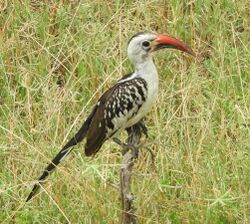Biology:Red-billed hornbill
| Red-billed hornbills | |
|---|---|

| |
| A northern red-billed hornbill (T. erythrorhynchus) at Tarangire NP | |
| File:Northern Red-billed Hornbill (Tockus erythrorhynchus) (022A-WA03044X0014-0010M0).ogg | |
| Call of T. erythrorhynchus | |
| Scientific classification | |
| Kingdom: | |
| Phylum: | |
| Class: | |
| Order: | |
| Family: | |
| Subfamily: | Bucerotinae
|
| Genus: | Tockus (in part)
|
The red-billed hornbills are a group of hornbills found in the savannas and woodlands of sub-Saharan Africa. They are now usually split into five species, the northern red-billed hornbill (Tockus erythrorhynchus), western red-billed hornbill (T. kempi), Tanzanian red-billed hornbill (T. ruahae), southern red-billed hornbill (T. rufirostris) and Damara red-billed hornbill (T. damarensis), but some authorities consider the latter four all subspecies of Tockus erythrorhynchus.[1]
Description
This group of conspicuous birds have mainly whitish underparts and head, grey upperparts, long tails, and a long curved red bill which lacks a casque. The sexes are similar, but the female has a smaller bill. They are generally large, at 42 centimetres (17 in) long, but the entire group is considered one of the smaller hornbills.
Behaviour
Breeding
During incubation, the female lays three to six white eggs in a tree hole that has been converted to a nest, which is blocked off with a plaster of mud, droppings and fruit pulp, with her inside, where she remains for a time after the eggs are hatched. The nest is built by both parents. Once the mother is inside the nest, there is only one narrow aperture, just big enough for the male to transfer food gathered from the outside habitat, to the mother and the chicks. When the chicks and the female are too big for the nest, the mother breaks out and rebuilds the wall, leaving the chicks inside for their continued protection from predators. Then both parents continued to feed the chicks.
Nesting
The female red-billed hornbill protects her young against intruders by building a wall across the opening of her nest. She then seals herself in and brings up her chicks in the enclosed space.
Feeding
They are omnivorous, taking and eating insects, fruit, seeds and even small rodents.[3] They feed mainly on the ground and will form flocks outside the breeding season.
Gallery
The southern species T. rufirostris is endemic to southern Africa
The northern red-billed hornbill has reddish ocular skin and dark eyes.
T. damarensis, illustration by Keulemans, 1892
T. kempi of West Africa is the only species with both dark eyes and black ocular skin
References
- ↑ "Red-billed Hornbill". Handbook of Birds of the World online. https://www.hbw.com/species/red-billed-hornbill-tockus-erythrorhynchus.
- ↑ Sinclair, Ian; Ryan, Peter (2010). Birds of Africa south of the Sahara (2nd ed.). Cape Town: Struik Nature. pp. 290–291. ISBN 9781770076235.
- ↑ "Twitch". https://www.twitch.tv/wildearth/clip/PlainVastHyenaDatSheffy-Ub7XQGbd70X-wRkT.
- BirdLife International (2016). "Tockus erythrorhynchus". IUCN Red List of Threatened Species 2016: e.T22725930A94906468. doi:10.2305/IUCN.UK.2016-3.RLTS.T22725930A94906468.en. https://www.iucnredlist.org/species/22725930/94906468. Retrieved 12 November 2021. Database entry includes justification for why this species is of least concern
- Birds of The Gambia by Barlow, Wacher and Disley, ISBN:1-873403-32-1
External links
- Red-billed Hornbill videos, photos & sounds on the Internet Bird Collection
- Red-billed hornbill - Species text in The Atlas of Southern African Birds.
Wikidata ☰ Q15708861 entry
 |








